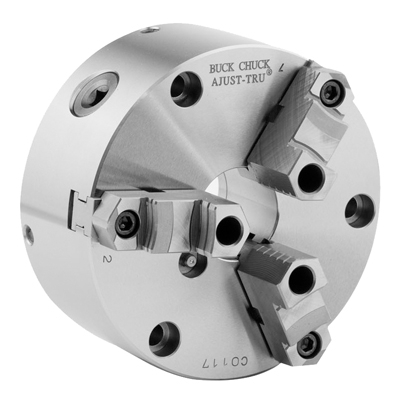
Buck Chuck Co. announces the release of its 20" ATSC scroll chuck to meet the demand for larger chucking options. This manual, self-centering scroll chuck is designed with a high-quality forged steel body construction to provide precision gripping, suitable for high-production runs.
The Ajust-Tru design, with integral clearance between the chuck body and the mounting adapter, allows for the use of adjusting screws for fine-tuning the concentricity of the chuck to the machine tool's spindle, providing +/-0.0005" TIR repeatability. To further optimize performance, the scroll plate, jaws and pinions are hardened and ground for precision and long wear.
The family of Buck ATSC manual scroll chucks range in size from 4" to 20" diameters with through-hole sizes from 1.04" up to 7.48". Additionally, most chuck sizes are available in model variations with either 3-jaw or 6-jaw designs. The new 20" ATSC chuck is a 3-jaw style and ships complete with master jaws and hardened, reversible top jaws for both ID and OD gripping, a spring-loaded T-wrench, an Allen wrench and mounting bolts. A variety of mounting plates are stocked for mounting the chuck to common machine spindles including American Standard styles A1, A2 and D1 camlock style. Other mounting plates can be manufactured on application.
"The level of precision and repeatability afforded by both the Ajust-Tru system and the accuracy of the ATSC operation make these manual chucks well-suited for lathe and turning center applications, as well as for holding parts in machining center applications and other processing systems requiring rotary-type fixturing," states Michele Marotz, Inside Sales Manager at Buck Chuck Co.
Contact Details
Related Glossary Terms
- chuck
chuck
Workholding device that affixes to a mill, lathe or drill-press spindle. It holds a tool or workpiece by one end, allowing it to be rotated. May also be fitted to the machine table to hold a workpiece. Two or more adjustable jaws actually hold the tool or part. May be actuated manually, pneumatically, hydraulically or electrically. See collet.
- clearance
clearance
Space provided behind a tool’s land or relief to prevent rubbing and subsequent premature deterioration of the tool. See land; relief.
- inner diameter ( ID)
inner diameter ( ID)
Dimension that defines the inside diameter of a cavity or hole. See OD, outer diameter.
- lathe
lathe
Turning machine capable of sawing, milling, grinding, gear-cutting, drilling, reaming, boring, threading, facing, chamfering, grooving, knurling, spinning, parting, necking, taper-cutting, and cam- and eccentric-cutting, as well as step- and straight-turning. Comes in a variety of forms, ranging from manual to semiautomatic to fully automatic, with major types being engine lathes, turning and contouring lathes, turret lathes and numerical-control lathes. The engine lathe consists of a headstock and spindle, tailstock, bed, carriage (complete with apron) and cross slides. Features include gear- (speed) and feed-selector levers, toolpost, compound rest, lead screw and reversing lead screw, threading dial and rapid-traverse lever. Special lathe types include through-the-spindle, camshaft and crankshaft, brake drum and rotor, spinning and gun-barrel machines. Toolroom and bench lathes are used for precision work; the former for tool-and-die work and similar tasks, the latter for small workpieces (instruments, watches), normally without a power feed. Models are typically designated according to their “swing,” or the largest-diameter workpiece that can be rotated; bed length, or the distance between centers; and horsepower generated. See turning machine.
- machining center
machining center
CNC machine tool capable of drilling, reaming, tapping, milling and boring. Normally comes with an automatic toolchanger. See automatic toolchanger.
- outer diameter ( OD)
outer diameter ( OD)
Dimension that defines the exterior diameter of a cylindrical or round part. See ID, inner diameter.
- through-hole
through-hole
Hole or cavity cut in a solid shape that connects with other holes or extends all the way through the workpiece.
- total indicator runout ( TIR)
total indicator runout ( TIR)
Combined variations of all dimensions of a workpiece, measured with an indicator, determined by rotating the part 360°.
- turning
turning
Workpiece is held in a chuck, mounted on a face plate or secured between centers and rotated while a cutting tool, normally a single-point tool, is fed into it along its periphery or across its end or face. Takes the form of straight turning (cutting along the periphery of the workpiece); taper turning (creating a taper); step turning (turning different-size diameters on the same work); chamfering (beveling an edge or shoulder); facing (cutting on an end); turning threads (usually external but can be internal); roughing (high-volume metal removal); and finishing (final light cuts). Performed on lathes, turning centers, chucking machines, automatic screw machines and similar machines.







